5 tips to breeze through managing your Microsoft 365 world
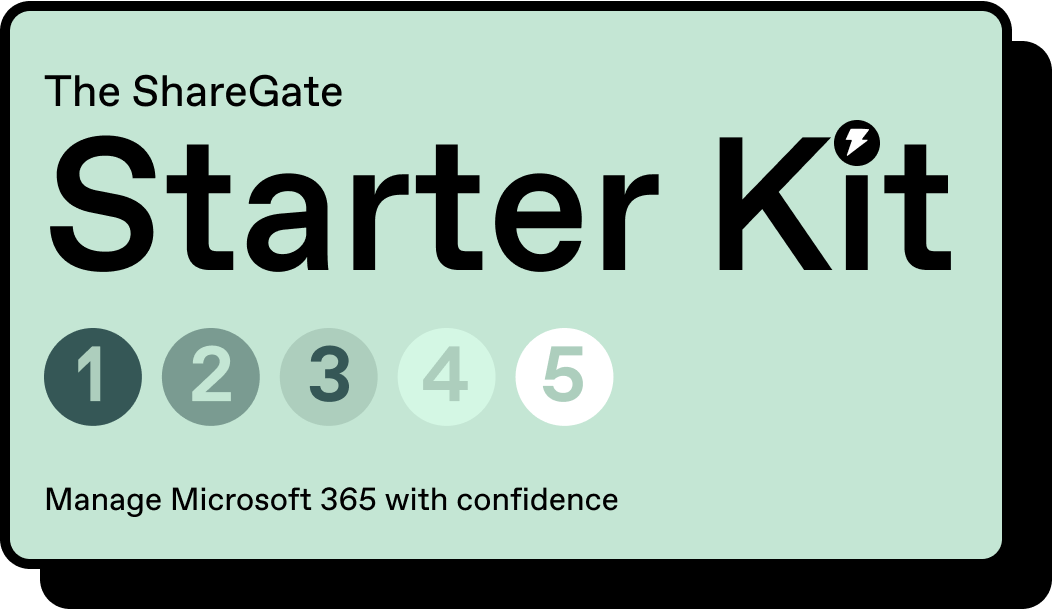
Good to know


Before you start
Before you start using ShareGate, take a few minutes to set yourself up for success.
- Have a global administrator approve ShareGate on your tenant for the first connection only. This will allow ShareGate to crawl your Microsoft 365 tenant daily and give you the visibility you need to manage your environment.
- While ShareGate completes the first crawl, take a moment to update the general settings, like communication preferences and notification strategies.
Get started

Set automated governance policies
Enforcing governance policies is key to keeping things in check in M365’s busy world of SharePoint and Teams. It’s all about ensuring only the right people have access to the right things and managing resources well.
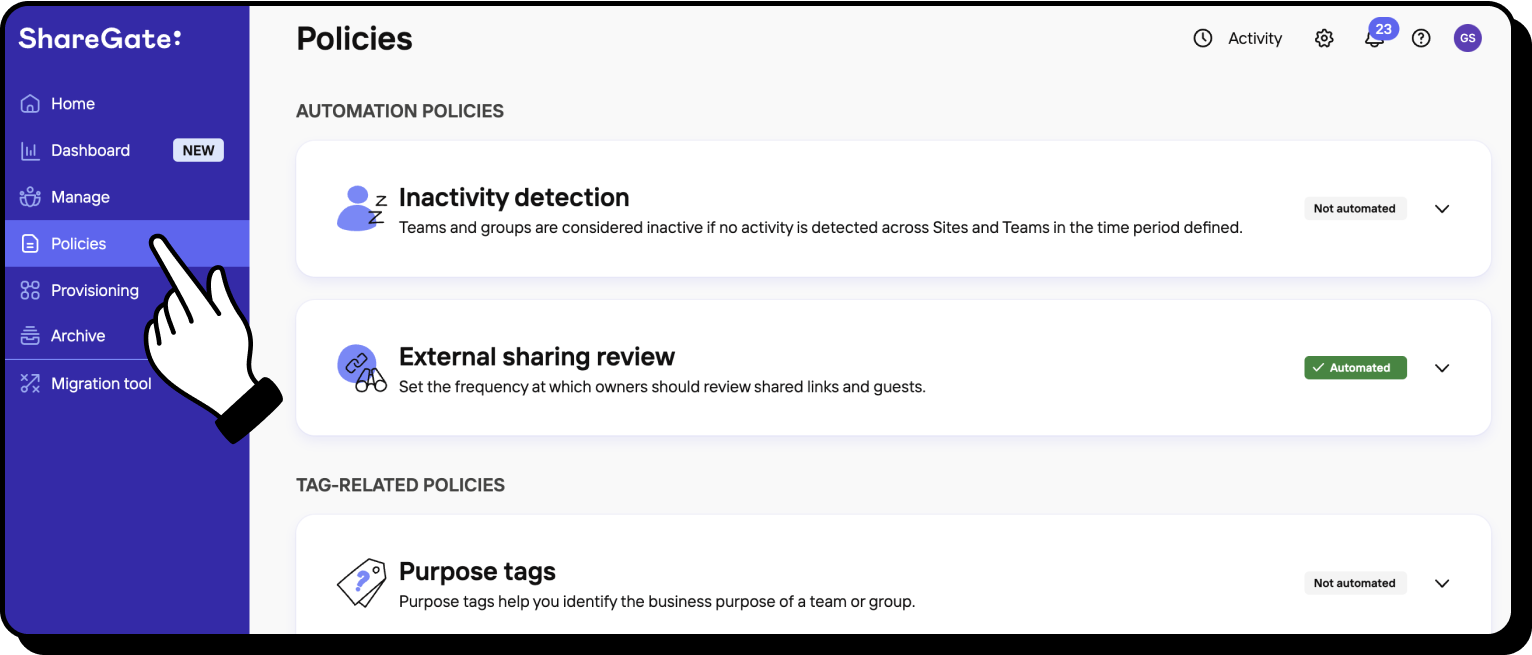
How it works
ShareGate gives you automated policies to help you maintain a secure and productive environment.
1. Inactivity detection
- ShareGate automatically finds inactive teams and sites in your tenant.
- Choose how many days without activity would qualify a team or site as inactive or leave ShareGate’s default 90-day threshold.
- Get granular with what inactivity looks like according to a team’s purpose.
- Keep, archive or delete inactive teams yourself or manually send notifications to the owners to act on them.
2. External sharing review
- Set the frequency at which owners should review their shared links and guests.
- You can enable ShareGate to automatically notify owners via the Teams chatbot or email when it’s time to review external links and guests. Owners can then remove any unnecessary links and guests.
3. Tags
- Customize your policies using purpose and sensitivity tags for security, administration, and the initial rollout.
Purpose tags
- Create purpose tags to categorize teams and groups according to the type of work being done.
- Apply tags yourself or let ShareGate prompt owners to choose the tag they feel best represents the purpose of the teams and groups they create.
Sensitivity tags
- Automatically update privacy, external sharing, and guest access settings accordingly.
- Create a range of tags to suit your needs, edit and maintain existing tags, and monitor how they’re being applied.

Create a workspace provisioning template
Without a provisioning strategy in place, you might find yourself dealing with issues that can drain your resources, such as redundant team sites, missing owners, and data loss risks.
Create provisioning templates for Teams and SharePoint sites with your guardrails built right in! That way, everyone can easily create the workspaces they need in M365, the right way.
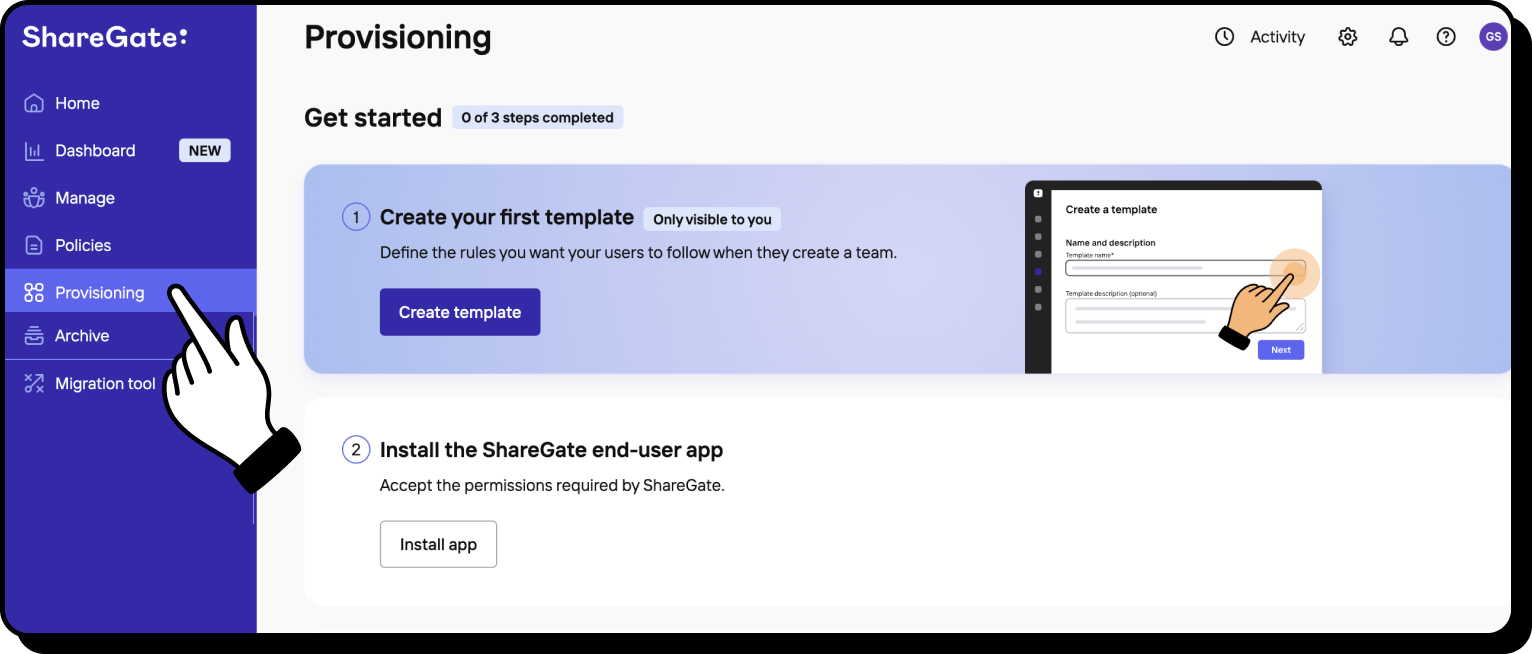
How it works
Building a template is simple!
To create a Teams template:
- Click Create template
- Select Team from the drop-down menu
- Name your template and add a description
- Define the rules of the template, including:
- Adding the minimum number of owners required
- Adding a naming convention (prefix, suffix, or both)
- Adding the number of approvers
- Whether the team will be public or private
- Pre-determined channels
- Adding security settings, such as privacy levels, external sharing settings, and guest access permissions
- You can also attach an active SharePoint site and sync its content and structure to use as a blueprint.
- And you can associate provisioned sites with a hub site.
To create a SharePoint template:
- Click Create template
- Select SharePoint site from the drop-down menu
- Name your template and add a description.
- Define the rules of the template, including:
- Adding the minimum number of owners required
- Adding a naming convention (prefix, suffix, or both)
- Adding the number of approvers
- You can also attach an active SharePoint site and sync its content and structure to use as a blueprint.
- And you can associate provisioned sites with a hub site.

Install the ShareGate end-user app
Once you’ve created your provisioning templates in ShareGate, your end users are ready to start using them so they can apply the right settings to their new workspaces right from the start. Here comes the really fun part: the ShareGate end-user app!

What is it?
- It’s an app integrated into Microsoft Teams. Users can easily access it in the Teams navigation bar.
- It’s where users create and manage their workspaces from start to finish.
- Everyone sees the teams and sites they own and are a part of and Teams meeting recordings.
- Users can review their external shares from the app.
Communication template
We get it. Everyone needs to feel confident with their new tech. To help you get users on board with the ShareGate end-user app, we created a sample email that can help you announce the implementation of ShareGate’s Teams app for Microsoft 365 provisioning within your organization.
Support your end users
Share these quick how-to guides so users get the hang of using the ShareGate end-user app:
- What is the ShareGate end-user app?
- How to create a new team with a template in ShareGate
- How to assign yourself as point of contact
- How to take action on inactivity
- How to review external shares
- How to take action on external sharing
- How to approve team creation requests
- How to find meeting recordings
- Who are admins, owners, and end users?

Quick wins for managing your Microsoft 365 environment
Wondering what’s happening in your environment? Who has access to what? What teams and groups have been created? How are they being used, if at all? ShareGate gives you full visibility to make sure your environment is running smoothly.
What is it?
Score some quick wins for managing your environment with these neat tools to keep things in check.
- Head to the Manage page for an overview of your teams, groups, and communication sites.
- Keep things tidy by catching inactive teams, orphaned teams, guests, and externally-shared links.
- Check the box beside the team or group names, and a bulk action menu will appear to show you the different actions you can take.
- Click the gear ⚙️ on the inactivity, purpose, guests/shared links, or sensitivity tile to navigate to the Policies page, where you can update your policies as needed.
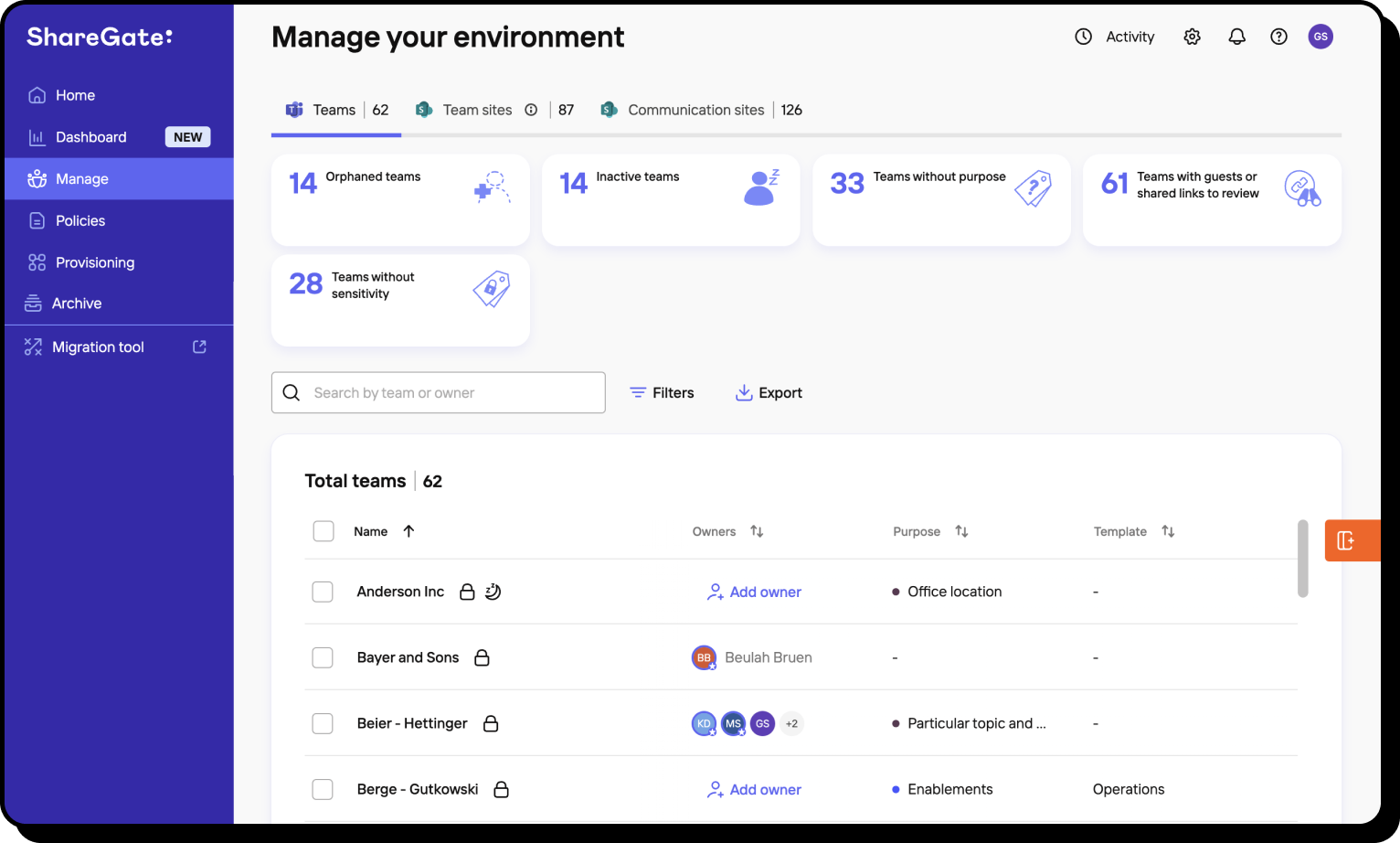
- Filter the page to find specific teams and groups and drill down into your data.
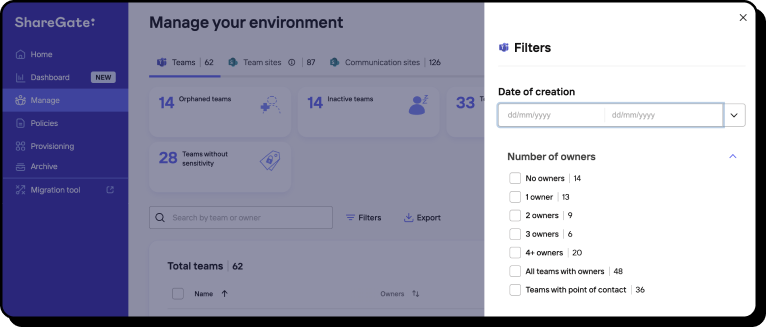
- Customize your columns to any view of your teams or groups list.
- Export as a CSV file for reference and analysis.
Here’s what Astrid from Oxford Instruments had to say about these tools in conversation with Benjamin Niaulin, ShareGate’s VP of Product.

Keep yourself in the know
While we’re on the topic of visibility, ShareGate helps you keep an eye on the big picture by giving you strong controls over what you monitor and what you’re notified about and when.
How it works
At ShareGate, we found that a few types of tools add value to any IT team managing Microsoft 365.
- Hop over to the Dashboard for a snapshot of what’s happening in your tenant.
- See what users are creating
- Monitor tenant health
- Get recommendations to help you stay on top of things
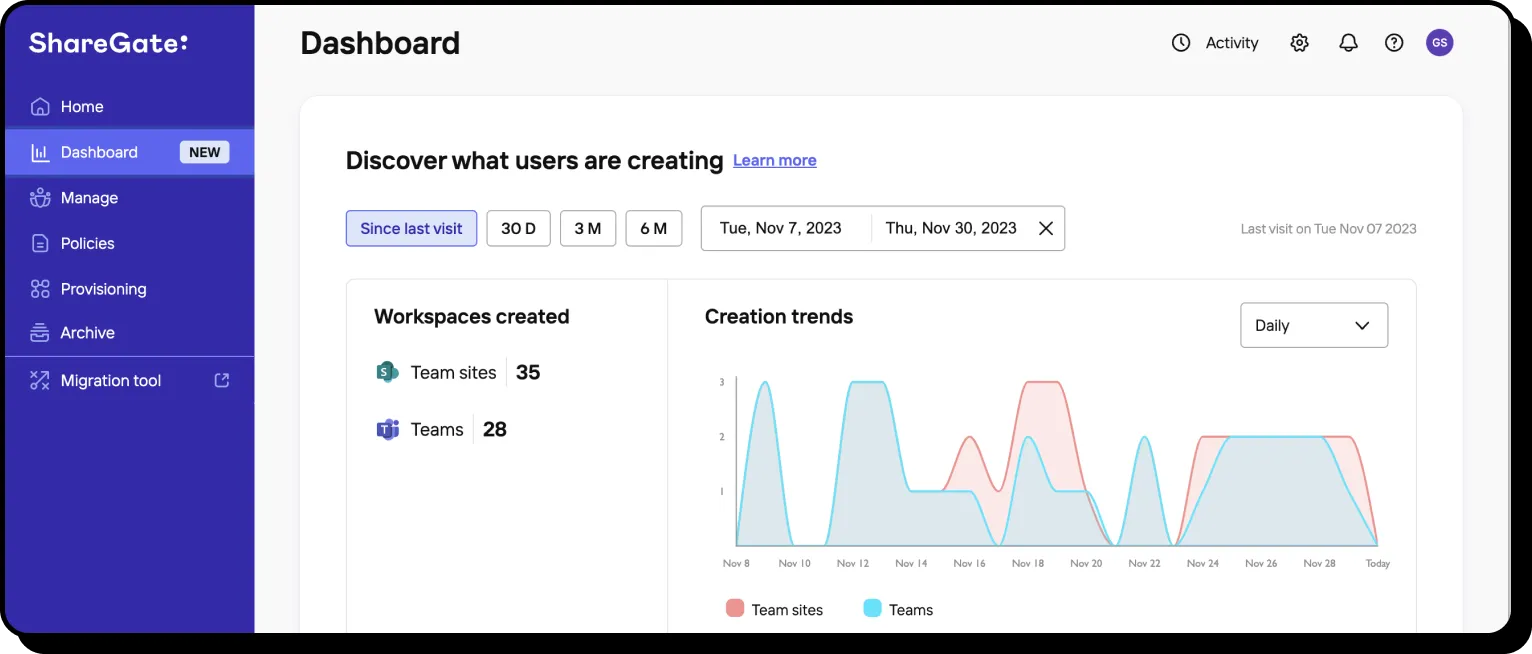
- Click on the gear ⚙️ to set up notifications to receive:
- A monthly digest about what’s happening, including reports on developing problems and actions you can take.
- Alerts via the chatbot when a team becomes inactive or orphaned, when a new team is created, and when a user deletes a team.
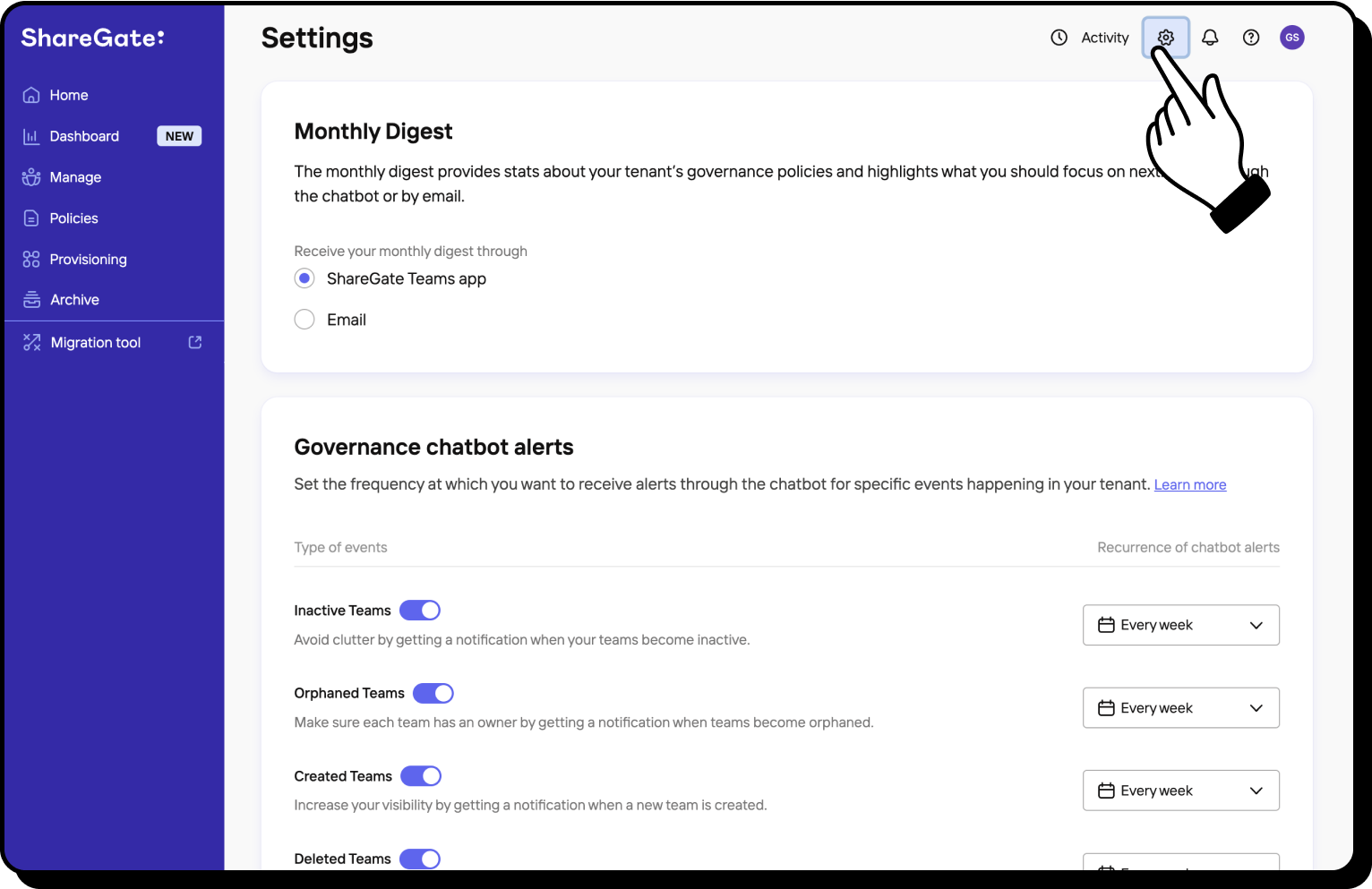
- Click on Activity in the top right to view your activity log, filter, and export.
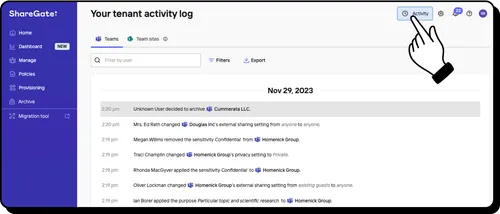


Got burning questions about ShareGate? Get answers straight from our experts!






